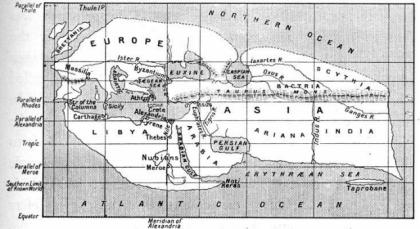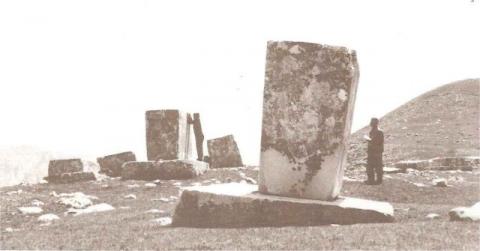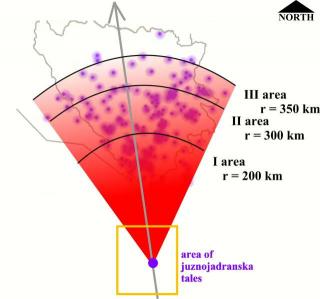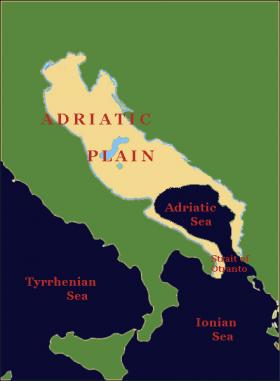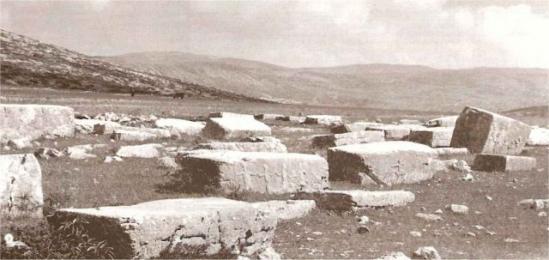
Scientists have been exploring several possible locations for Atlantis, which is, according to Plato, »the island beyond the pillars of Hercules«: Malta, Cuba, the Bahamas, Santorini etc. Here is the theory regarding the original location of the Pillars of Hercules which allows for the possibility that Atlantis was located in today's Adriatic Basin.

Silent Witnesses of Destruction
Fatih Hodzic
Atlantis was an ancient kingdom, a state with a perfect social system, the cradle of civilization, an island »beyond the Pillars of Hercules«. This is what Plato, a classical Greek philosopher, wrote about Atlantis in his dialogues »Timaeus« and »Critias« in about 350 BC. Critias, who was a Greek politician and writer, relates in his papers on the state, law and justice that in 571 BC Athenian statesman Solon visited Egypt and met with priests in the town of Sais where he was told a story about »an island named Atlantis, the heart of a great and wonderful kingdom«.
Plato wrote that »there occurred violent earthquakes and floods; and in a single day and night of misfortune all your warlike men in a body sank in the earth, and the island of Atlantis in like manner disappeared in the depths of the sea«. There are numerous ancient accounts of the catastrophe of such extent. Even though they are dominated by mythical themes, the narrations contain convincing descriptions of the sinking which can be analyzed and confirmed scientifically.
THE RETURN OF THE PILLARS OF HERCULES
The aforementioned theory about the pillars locations offers enough indications that the Pillars of Hercules can be »moved« again, or rather returned to their place in Solon's era: to the Strait of Otranto, which connects the Ionian and Adriatic Seas and is located 360 kilometers from Sicily. One of the continents in the sea, the Palagruža Sill, divides the Adriatic Sea into the shallow northern part and the southern part with the South Adriatic Basin in the great syncline.
Hercules transmits pillars
(16th century, Museo civico Ala Ponzone-Cremona)
Before the Flood this area was part of the kingdom of Atlantis which also comprised other islands and the continent around the Adriatic and Ionian Seas. The southern and central parts of the "island" were flat like the coastlines of nearby Apulia, Albania and flat nearby Po river. The northern part was mountainous and abundant in forests, rivers and lakes. Not far from the island, which was said »to be very lofty and precipitous on the side of the sea«, lies the Gargano Promontory on the Apennine Peninsula. On the other side of the Adriatic Sea there is the mountainous region of the Dinarides, from the Alps in the north to the Prokletije range and Šar Mountains.
Due to the extraordinary location and the Mediterranean climate, the influence of the cold north was negligible, or as Plato wrote: »This part of the island looked towards the south, and was sheltered from the north.«
THE FALL OF AN ASTEROID
One of the possible events which triggered the chain reaction in an unstable environment and caused a catastrophe of unspoken proportions was the fall of an asteroid. This possibility is indicated by huge caves in the Tyrrhenian Sea or Ionian Sea not far from the Gulf of Taranto and is also supported by a story about the fall of an asteroid which was told to Solon by a priest from Sais: »There is a story, which even you have preserved, that once upon a time Paethon, the son of Helios, having yoked the steeds in his father’s chariot, because he was not able to drive them in the path of his father, burnt up all that was upon the earth, and was himself destroyed by a thunderbolt …« And he explained: »Now this has the form of a myth, but really signifies a declination of the bodies moving in the heavens around the earth, and a great conflagration of things upon the earth, which recurs after long intervals.« After the asteroid falling and the heat wave which followed, the most energy was released in the form of tsunamis, extremely high waves. The sinking and devastation were accompanied by destructive earthquakes. Parts of the Adriatic micro plate broke off and sank. The areas of land and sea changed throughout centuries after the cataclysm. Thick clouds of dust and ashes in the highest layers of the atmosphere created all necessary conditions for extreme climatic changes and cooling. Judging from the geological periods and time stated by the priests from Sais, the cataclysm occurred around 8500 BC. This period belongs to the cold Paleolithic and the beginning of the Holocene epoch with the Mesolithic Age when the climate finally stabilized.
THE KINGDOM OF ATLANTIS
The epoch of Atlantis started when it was awarded to one of the »gods«, Poseidon. The island boasted natural resources and beauty, later also urban towns and an imposingly built metropolis, the royal city. Part of the metropolis with the temple of Poseidon and the royal palace of Atlant, the oldest Poseidon’s son, was surrounded by three concentric sea channels. Inhabitants of Atlantis raised walls around the channels and »placed towers and gates on the bridges where the sea passed in«. The kingdom of Atlantis encompassed the Balkan Peninsula (Greek regions and the Dinarides) and the Apennine Peninsula up to Tyrrhenia (named Tuscany today) and reached down to Malta and Crete in the south. This territory of the kingdom »was greater in extent than Libya and Asia«. The period of expansion in the Mediterranean was marked by the conflicts and wars between the forces of Atlantis and ancient Athenians, who were much like the Atlanteans the descendants of »the fairest and noblest race of men which ever lived«. Plato indirectly speaks about the law-abiding kings of Atlantis and their divine nature which gradually disappeared by procreating with mortals. Due to genetic identity and co-dependency of mortals and immortals, the number of human elements in the »god’s« seeds increased. The final situation on Atlantis was represented by »the domination of the human ethos« and the beginning of wars for the throne, such as the battle with ancient Athenians. Critias speaks about the military force of kings »which unprovoked made an expedition against the whole of Europe and Asia, and to which your city put an end. This power came forth out of the Atlantic Sea, for in those days the Atlantic was navigable«. During the wars »there occurred violent earthquakes and floods; and in a single day and night of misfortune all your warlike men in a body sank into the earth, and the island of Atlantis in like manner disappeared in the depths of the sea«. Solon also heard that »there was a time, before the great deluge of all, when the city which now is Athens was first in war and in every way the best governed of all cities, is said to have performed the noblest deeds and to have had the fairest constitution of any of which tradition tells, under the face of heaven …«
ATLANTIS AND THE ADRIATIC BASIN
There are interesting similarities between Critias’ statements about Atlantis and the characteristics of the Adriatic Basin: In Solon’s era the phrase »the city which now is Athens« referred to parts of Greece, Dalmatia, southern Italy and Albania.
Critias spoke about a plateau which »was for the most part rectangular and oblong, and where falling out of the straight line followed the circular ditch«. The Adriatic Basin (the Adriatic plain) actually has a form of a rectangle whose opposite sides go from north to south and from west to east.The Atlanteans used stone for building: »one kind was white, another black, and a third red«. White and black stone is still quarried on Island Brač (Croatia) and red stone in the Bay of Kotor (Montenegro).
»There was an abundance of wood for carpenter's work, and sufficient maintenance for tame and wild animals. Moreover, there were a great number of elephants in the island.« The remnants of elephant skeletons have been found in central and southern Italy as well as on the eastern coast of the Adriatic Sea close to Island Pag and Dramlje near the town of Crikvenica (Croatia). The skeletons date back to the Pleistocene, more than 9000 years before Hannibal’s march with elephants to Rome.
The Atlanteans dug and melted ores as well as mined and used orichalcum or brass – a copper-zinc alloy. The territory along the Adriatic Basin is rich in ores and minerals, including copper and zinc. There are many forests as well as rivers and cold- and thermal water springs.
In the vicinity of the sunken island, there are unique inland seas on Mljet (Croatia), the island of underground dwellings, caves and mud-lakes. Up until 9000 BC the inland seas contained fresh water.
Jabuka and Brusnik are two of the 1185 islands in the Adriatic Sea which were formed when lava flow reached the sea. Along with Island Palagruža, which is of partial volcanic origin, they form the »Adriatic volcanic triangle«.

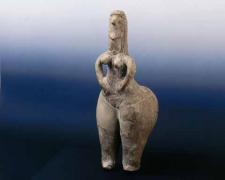
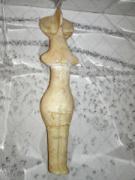
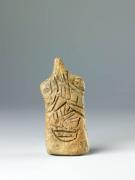
Statues of Venus: from Willendorf, Vinča, Tripolye, Murska Sobota ...
Necropolis with stećaks
STEĆAKS
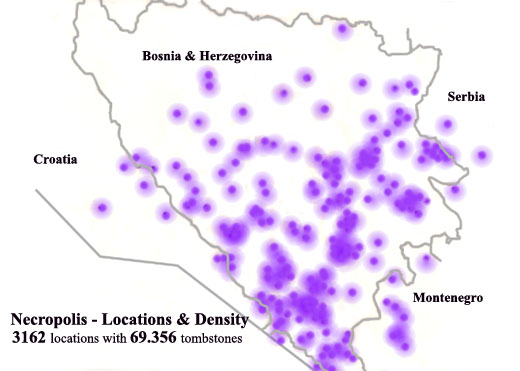
NO RELIABLE EXPLANATION
ATLANTIS – THE HISTORICAL FACT
The theory which rejects the myth of Atlantis and regards it as historical fact is based on the following premises:
· The consequences of the floods are manifested in alluvial material and layers of silt, sand and other materials on the broader region of southern Italy, Albania, Bosnia and Herzegovina, and the bottom of the Adriatic Sea. The alluvia of small stones agglutinated with sand and clay and created breccia and a conglomerate, sedimentary stone which can be found in the mountainous parts of Albania, Bosnia and Croatia, along with fossilized sea organisms.
· A tsunami scattered the stone blocks across a circular sector area. The areas closer to the sea were more exposed to the destructive forces of the giant waves, so more stone blocks, which were also bigger in size, were scattered there. In the Dinaric region most stone blocks or necropolises with stećaks were situated on the south side and on mountain slopes facing the sea.
· The center of the circular sector is part of the tectonic fabric of the Adriatic micro plate in the southern part of the Adriatic Sea.The stone blocks–monuments cut in a certain period and space are legacy and indigenous treasure of the kingdom of Atlantis. Stone blocks–stećaks which were later hewn and decorated with inscriptions and reliefs are legacy of the culture from the Bosnian Church era. As monuments and as stećaks they are a valuable treasure from both prehistoric and medieval times. They are silent witnesses of an ancient cataclysm and artefacts of two cultures. Before the sinking the South Adriatic Basin and Palagruža Sill in the Adriatic Sea was the original location of the stone blocks–monuments. This area in the sea is where sunken Atlantis, the cradle of our civilization, has been lying for a hundred and more centuries. And then...
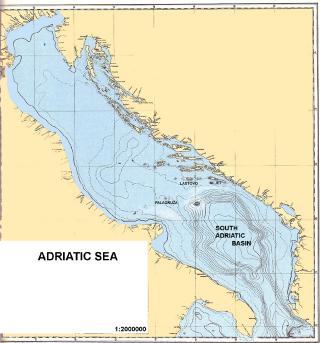
11.000 years ago
the area of todays north and middle Adriatic sea was land, part of large adriatic plain...
OTHER ARTICLES
(about Atlantis, the Megaliths... about Human Development, the Consciousness...)
Since the Arrival of the Upright Man
The first upright man, the common ancestor of all people lived in areas of Africa more than 1.5 million years ago. He was a man of the hominin tribe and by genus a Homo erectus. Descendants and later generations of Homo erectus settled gradually, apart from Africa, in areas of Europe and Asia, where they evolved through a number of species and subspecies, from Homo antecessora, Heidelberg, Rhodesian and Beijing man to Neanderthals, Cro-Magnon, etc. The human species Homo sapiens appears in one continuous development of vertical men, becoming more distinct and separated by habitat, their geographic area. It is primarily on the African, European (Mediterranean) and the Asian pool and a time frame between 200,000 - 70,000 years ago that this happened. Thus, starting with Homo erectus, a common African ancestor, ancestors of archaic and modern humans in Europe were the Homo anteccesor, Heidelberg man and the Neanderthal, and the ancestors of modern humans in Asia were Homo georgicus the Peking Man, and in Africa, Homo ergaster, Homo gautengensis, Homo rhodensiensis and the African type of the Heidelberg man. Their common ancestor, Homo erectus evolved from the Homo habilis species, whose ancestors have been in the genus Australopithecus africanus, one of transitional forms in the development of hominids...
 Since the Arrival of the Upright Man (.pdf 171KB)
Since the Arrival of the Upright Man (.pdf 171KB)The Unknown Era of the Megalith
Just as we do today, so have generations of descendants of megalithic builders wondered about the monumental and mysterious megalithic buildings. In the old traditions and beliefs, megalithic builders have acquired increasing features of people with supernatural, almost divine powers and abilities. So it is not unusual that these same megalithic builders were recognized as characters in a number of mythological motifs that are honored and invoked in the rites and rituals. When the construction sites of megaliths - especially on European soil – are shown on the ancient Greek world maps, ones from times of Home, Hesiod and Hecataeus, interesting details can be observed. Where some of the oldest and most magnificent megalithic monuments are, the old Greek charts are showing them as elision and happy paradise islands in the outer ocean or as a temporary residence of the deceased and the demigods and gods. The area west of Sicily to the mouth of the river and the islands of Corsica and Sardinia are places where Cyclops, satyrs, centaurs, Lamia, Scylla and Charybdis lived... Strange creatures, half-human and half-animal which Odysseus encountered sailing lost in the seas.
About the divine and divinity in the superhuman megalithic builders remain myths and legends to be told. About the ability of these same people in some different exceptional circumstances on Earth, thousands of megalithic buildings and structures are telling the tale. One of the megalithic builders could be renamed as Hercules, who not only set but replaced its monumental pillars...
 The Unknown Era of the Megalith (.pdf 199KB)
The Unknown Era of the Megalith (.pdf 199KB)
On principles of consciousness - A novel hypothesis
Based on studies of activities in the diencephalon, the reticular formation and the workspace of the thalamus and the hippocampus, it is important to accentuate the role of the latter as a pacemaker in creating thalamic activity and activation waves. The appearance of waves, synchronous oscillations and rhythmic activities in reticular-thalamic and limbic system lead to the majority of cortical activations. In addition, the role of myelin and myelin proteins in a cognitive model of conscious processes is perceived in a completely different light. Myelin is essential for normal functioning of the nerve fibers and crucial for activities and activations in the central nervous system - CNS. Understanding the thalamic-limbic activity and the thalamic dopaminergic system, the role of myelin and the relatively high content of myelin in the thalamic activation and processing system (in the thalamus, the hippocampus and basal ganglia) as the correlates of consciousness, is certainly a beginning for understanding the principles of consciousness...
 Hypothesis - On Principles of Consciousness (.pdf 696KB)
Hypothesis - On Principles of Consciousness (.pdf 696KB) Contact : Fatih Hodzic
© Copyright Fatih Hodzic 2007-2017 All Rights Reserved.
